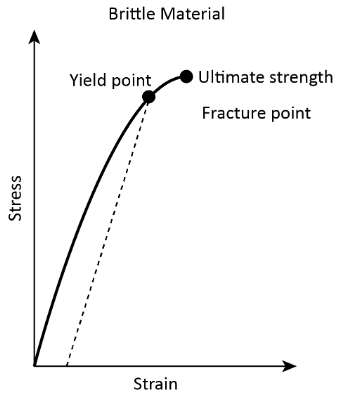
Assertion (A): Silver is a ductile material,
Reason (R): For a ductile material, yield point and breaking point are separated by a larger distance than for brittle materials on the stress- strain curve.
A. Both assertion and reason are true and the reason is the correct explanation of the assertion.
B. Both assertion and reason are true, but reason is not correct explanation of the assertion
C. Assertion is true , but the reason is false
D. Assertion is false, but the reason is true
Answer
475.8k+ views
1 likes
Hint:Ductile materials can bear significant plastic deformation prior to the breaking point whereas in the case of brittle materials, it can bear very small plastic deformation prior to the breaking point. Ductile material absorbs more energy as compared to the brittle material.
Complete answer:
We know that when an external force or load applied on a material, it deforms plastically (can able to regain its original shape and size) then deforms plastically (permanent change in shape and size).Now we know that the ductile materials are those materials that can bear significant plastic deformation before fracture or breaking. This type of material absorbs a large amount of energy before breaking. Some examples of such materials are aluminium, silver, copper, rubber, etc.
The figure below represents the stress and strain curve of the ductile material:

Brittle materials are those materials that exhibit minor plastic deformation before breaking and they absorb a very small amount of energy before breaking. Example: concrete, glass, cast iron, stone, etc.
The figure below represents the stress and strain curve of the brittle material:

The yield point is the point beyond which the materials start deforming plastically and the breaking point is the point at which the material breaks or fracture takes place.We know that silver is a ductile material. So, the assertion is correct.Ductile material undergoes significant plastic deformation and the distance between the yield point and the fracture point is very large as compared to brittle material.
Hence, the correct option is A.
Note:The ultimate strength of the material is the maximum value of stress that a material bears without undergoing any breakage or fracture. The ultimate strength of the ductile material is more than the brittle material as ductile material absorbs more energy.
Complete answer:
We know that when an external force or load applied on a material, it deforms plastically (can able to regain its original shape and size) then deforms plastically (permanent change in shape and size).Now we know that the ductile materials are those materials that can bear significant plastic deformation before fracture or breaking. This type of material absorbs a large amount of energy before breaking. Some examples of such materials are aluminium, silver, copper, rubber, etc.
The figure below represents the stress and strain curve of the ductile material:

Brittle materials are those materials that exhibit minor plastic deformation before breaking and they absorb a very small amount of energy before breaking. Example: concrete, glass, cast iron, stone, etc.
The figure below represents the stress and strain curve of the brittle material:

The yield point is the point beyond which the materials start deforming plastically and the breaking point is the point at which the material breaks or fracture takes place.We know that silver is a ductile material. So, the assertion is correct.Ductile material undergoes significant plastic deformation and the distance between the yield point and the fracture point is very large as compared to brittle material.
Hence, the correct option is A.
Note:The ultimate strength of the material is the maximum value of stress that a material bears without undergoing any breakage or fracture. The ultimate strength of the ductile material is more than the brittle material as ductile material absorbs more energy.
Latest Vedantu courses for you
Grade 10 | MAHARASHTRABOARD | SCHOOL | English
Vedantu 10 Maharashtra Pro Lite (2025-26)
School Full course for MAHARASHTRABOARD students
₹33,300 per year
Recently Updated Pages
Master Class 11 Economics: Engaging Questions & Answers for Success

Master Class 11 Business Studies: Engaging Questions & Answers for Success

Master Class 11 Accountancy: Engaging Questions & Answers for Success

Master Class 11 English: Engaging Questions & Answers for Success

Master Class 11 Computer Science: Engaging Questions & Answers for Success

Master Class 11 Maths: Engaging Questions & Answers for Success

Trending doubts
State and prove Bernoullis theorem class 11 physics CBSE

1 ton equals to A 100 kg B 1000 kg C 10 kg D 10000 class 11 physics CBSE

State the laws of reflection of light

One Metric ton is equal to kg A 10000 B 1000 C 100 class 11 physics CBSE

1 Quintal is equal to a 110 kg b 10 kg c 100kg d 1000 class 11 physics CBSE

Difference Between Prokaryotic Cells and Eukaryotic Cells




